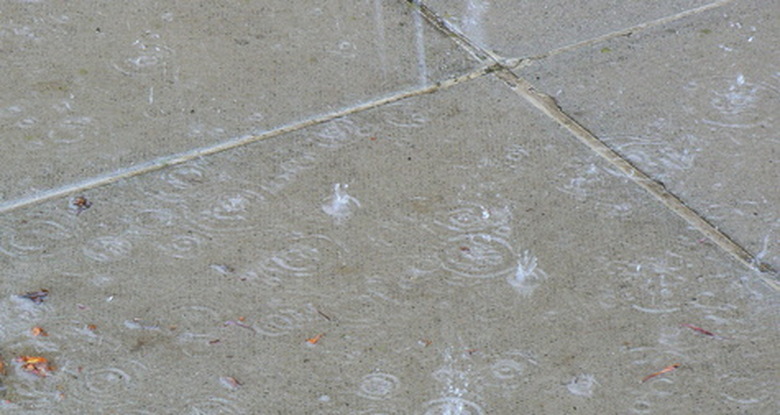How To Repair Concrete That Has Been Rained On
Things Needed
-
Concrete saw
-
Diamond concrete grinding machine or sander with diamond head
-
Plastic sheeting (to minimize rain damage)
-
Safety goggles
As concrete dries, one of the worst things that can happen is for rain to start falling. In addition to causing pits in the surface of the concrete when the raindrops hit it, rain falling on uncured concrete can change the water-cement ratio in the concrete's top layer. Troweling or otherwise attempting to finish the water into the concrete results in a rough, powdery layer forming on top of the concrete that is more likely to crumble and crack than properly cured concrete. Most damage done to concrete by rain can be fixed by removing the affected layer with specialized tools.
Step 1
Cover the concrete with plastic sheeting as soon as possible after the rain starts. Weigh the plastic down to prevent it from blowing away, and cover the concrete as completely as possible. The plastic sheeting will prevent much of the water from coming in contact with the drying concrete, and though it may leave an impression in the concrete it will not damage its consistency.
Step 2
Remove the plastic once the rain has stopped and allow the concrete to dry fully. If the plastic was applied prior to the rain beginning to fall or very little water came in contact with the concrete before it was covered, the surface may be smoothed with a trowel to remove indentations from the plastic sheeting.
Step 3
Examine both the top and the edges of the dried concrete, looking for signs of damage. If the top of the concrete was damaged by the water it will appear rough and powdery and may be brittle. If the edges are damaged they will display a similar texture down the side of the dried concrete and may have acquired a rough edge.
Step 4
Use a concrete saw to remove severely eroded edges, cutting through the full depth of the concrete to restore it to a smooth side. If minimal erosion has occurred or the sides were reinforced with wood or other bracing material at the time of the rainfall, this will not be necessary.
Step 5
Use a diamond concrete grinding machine or an industrial sander that has been fitted with a diamond head to grind through the brittle top layer of the concrete if it has been compromised by the rain. Even heavy rains will generally only affect 1/4 inch or less of the concrete, according to the American Concrete Pavement Association, so extensive grinding will not be necessary. Grind or sand the surface until the powdery concrete has been removed and the dense concrete below is showing through, then rinse the surface to remove all concrete powder.
Warning
Wear safety goggles to protect your eyes when cutting or grinding concrete, and observe all safety precautions on the tools that you use.
